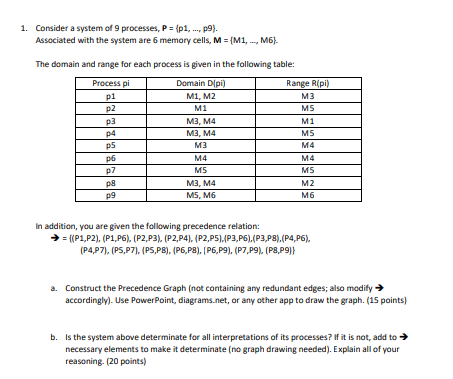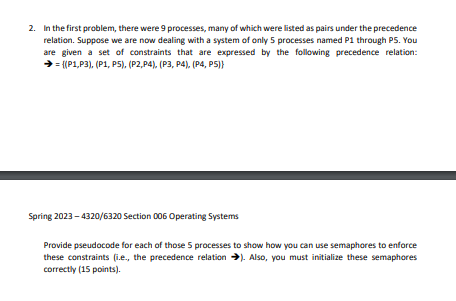Answered step by step
Verified Expert Solution
Question
1 Approved Answer
All copies answers will receive a downvote and a report, so please do not copy any other answers. This is all the information i was


All copies answers will receive a downvote and a report, so please do not copy any other answers. This is all the information i was given.
1. Consider a system of 9 processes, P={p1,,p9}. Associated with the system are 6 memory cells, M={M1,,M6}. The domain and range for each process is given in the following table: In addition, you are given the following precedence relation: ={(P1,P2),(P1,P6),(P2,P3),(P2,P4),(P2,P5),(P3,P6),(P3,P8),(P4,P6), (P4,P7),(PS,P7),(PS,PB),(PG,PB),[PG,P9),(P7,P9),(PS,P9)} a. Construct the Precedence Graph (not containing any redundant edges; also modify accordingly). Use PowerPoint, diagrams.net, or any other app to draw the graph. (15 points) b. Is the system above determinate for all interpretations of its processes? If it is not, add to necessary elements to make it determinate (no graph drawing needed). Explain all of your reasoning. (20 points) 2. In the first problem, there were 9 processes, marty of which were listed as pairs under the precedence relation. Suppose we are now dealing with a system of only 5 processes named P1 through P5. You are given a set of constraints that are expressed by the following precedence relation: ={(P1,P3),(P1,P5),(P2,P44),(P3,P4),(P4,P5)} Spring 20234320/6320 Section 006 Operating Systems Provide pseudocode for each of those 5 processes to show how you can use semaphores to enforce these constraints (i.e., the precedence relation ). Also, you must initialize these semaphores correctly (15 points)Step by Step Solution
There are 3 Steps involved in it
Step: 1

Get Instant Access to Expert-Tailored Solutions
See step-by-step solutions with expert insights and AI powered tools for academic success
Step: 2

Step: 3

Ace Your Homework with AI
Get the answers you need in no time with our AI-driven, step-by-step assistance
Get Started


